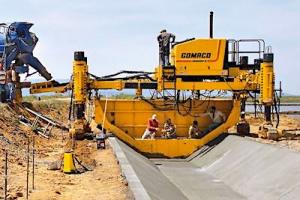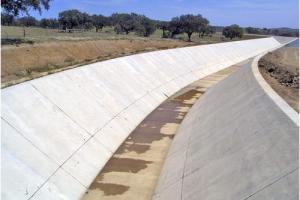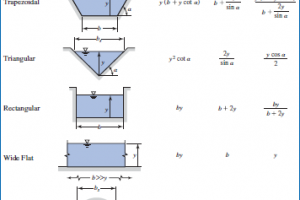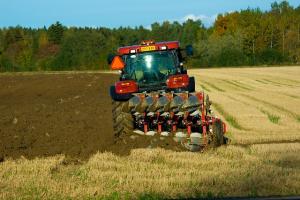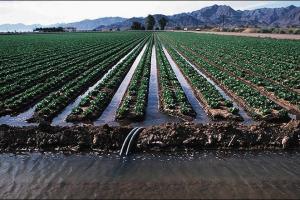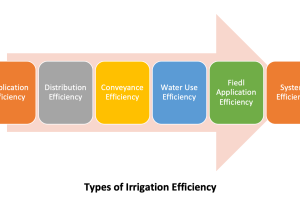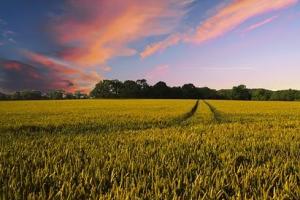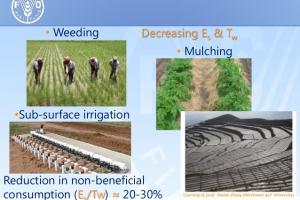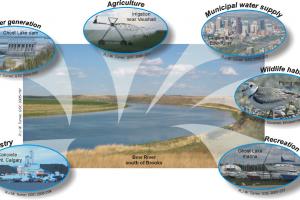Definition and Types of Cross Drainage Works
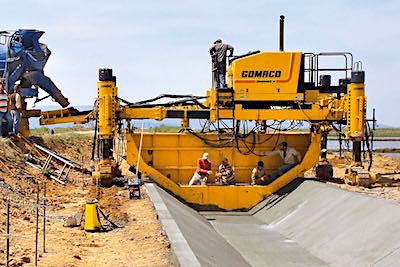
Definition:
A cross drainage work is a structure carrying the discharge from a natural stream across a canal intercepting the stream. Canal comes across obstructions like rivers, natural drains and other canals. The various types of structures that are built to carry the canal water across the above mentioned obstructions or vice versa are called cross drainage works. It is generally a very costly item and should be avoided by:
- Diverting one stream into another.
- Changing the alignment of the canal so that it crosses below the junction of two streams.
Types of Cross Drainage Works
Depending upon levels and discharge, Cross Drainage Works may be of the following types: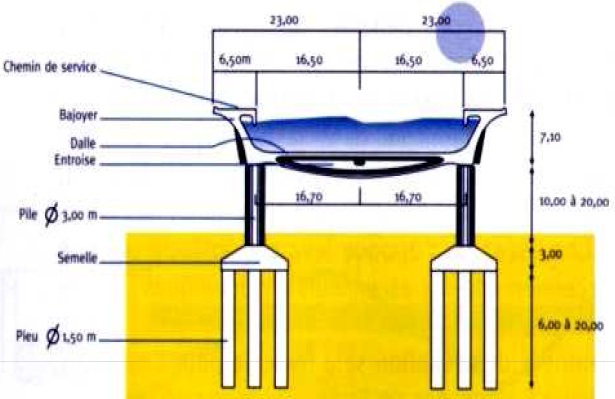
- Aqueducts
- Culverts
- Siphons
- Syphons
- Bridges
- Causeways
- Siphon Aqueduct
- Super passage
Aqueduct:
Aqueducts are water channels or pipelines constructed over or under a natural or artificial obstacle, such as a river or a road. They are used to convey water from one side of the obstacle to the other without any interruption in the flow. When the HFL of the drain is sufficiently below the bottom of the canal such that the drainage water flows freely under gravity, the structure is known as Aqueduct.
- In this, canal water is carried across the drainage in a trough supported on piers.
- Bridge carrying water
- Provided when sufficient level difference is available between the canal and natural and canal bed is sufficiently higher than HFL.
Culverts:
Culverts are underground or overhead structures that allow the passage of water underneath roads, railways, or embankments. They are typically made of reinforced concrete, metal, or other durable materials and come in various shapes, such as circular, rectangular, or elliptical.
Siphons:
Siphons are inverted U-shaped structures that use the principle of a siphon to transport water over an obstruction. They consist of pipes or conduits that rise above the water level on one side, cross over the obstacle, and then descend to the water level on the other side.
Canal Syphon:
A canal siphon, also known as a syphon, is a specific type of cross drainage work used in irrigation or water distribution systems. It allows water to be carried under pressure from one side of an obstruction, such as a river or a road, to the other side. A canal siphon consists of a pipe or conduit that is partially submerged in the water source on one side of the obstacle. The water in the canal is then allowed to flow into the pipe, creating a siphoning effect. The siphon carries the water under pressure, over the obstacle, and discharges it into the receiving canal on the other side.
In Cross Drainage Works, Canal siphons are commonly used when the elevation on the downstream side of the obstacle is lower than the upstream side. They provide a cost-effective and efficient solution for conveying water across obstacles without the need for pumping stations.
- If two canals cross each other and one of the canals is siphoned under the other, then the hydraulic structure at crossing is called “canal siphon”. For example, lower Jhelum canal is siphoned under the Rasul-Qadirabad (Punjab, Pakistan) link canal and the crossing structure is called “L.J.C siphon”
- In case of
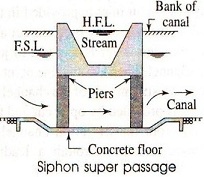 siphon the FSL of the canal is much above the bed level of the drainage trough, so that the canal runs under the siphonic action.
siphon the FSL of the canal is much above the bed level of the drainage trough, so that the canal runs under the siphonic action. - The canal bed is lowered and a ramp is provided at the exit so that the trouble of silting is minimized.
- Reverse of an aqueduct siphon
- In the above two types, the inspection road cannot be provided along the canal and a separate bridge is required for roadway. For economy, the canal may be flumed but the drainage trough is never flumed.
Syphons:
Syphons, also known as inverted siphons, are similar to siphons but are designed to carry water under an obstacle instead of over it. They are used when the elevation on the downstream side is lower than the upstream side, creating a need for the water to be carried under pressure.
Bridges:
Bridges are structures built to span a watercourse or any other obstruction. They provide a passage for both water and other forms of transportation, such as roads or railways. Bridge designs vary depending on the specific requirements of the site, including the width and depth of the water body.
Causeways:
Causeways are embankments or raised pathways constructed across wetlands, marshes, or shallow water bodies. They are typically made by filling in the area with earth or other suitable materials. Causeways can provide a cost-effective solution for crossing relatively low-lying or less significant water channels.
These are some of the common types of cross drainage works used in hydraulic engineering. The selection of the appropriate type depends on factors such as the nature of the obstacle, the volume of water to be conveyed, the topography of the area, and the cost and engineering feasibility of the structure.
Siphon Aqueduct:
A siphon aqueduct is a type of cross drainage work that combines the features of both an aqueduct and a siphon. It is designed to carry water over an obstacle, such as a valley or a depression, using the principle of a siphon.
In a siphon aqueduct, a pipeline or conduit is constructed with one end higher than the other, creating a slope or gradient. The higher end of the pipeline is connected to a water source, while the lower end is connected to the receiving water body on the other side of the obstacle.
The siphon aqueduct operates based on the principle of gravity and the partial vacuum created by the siphoning effect. When the water level in the source side is higher than the water level on the other side, gravity causes the water to flow down the pipeline, creating a siphon effect. This allows the water to be carried across the obstacle without the need for pumps or external energy.
The siphon aqueduct is particularly useful in situations where the terrain or topography makes it impractical or costly to construct a conventional aqueduct or bridge. It offers a cost-effective and energy-efficient solution for transporting water over natural depressions or valleys.
In case of the siphon Aqueduct, the HFL of the drain is much higher above the canal bed, and water runs under siphonic action through the Aqueduct barrels.
The drain bed is generally depressed and provided with pucci floors, on the upstream side, the drainage bed may be joined to the pucca floor either by a vertical drop or by glacis of 3:1. The downstream rising slope should not be steeper than 5:1. When the canal is passed over the drain, the canal remains open for inspection throughout and the damage caused by flood is rare. However during heavy floods, the foundations are susceptible to scour or the waterway of drain may get choked due to debris, tress etc.
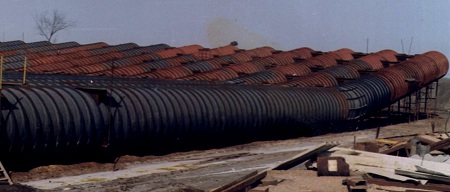
Cross drainage works carrying drainage over canal.
Super Passage:
A super passage is a type of cross drainage work designed to provide a passage for both water flow and the movement of wildlife or aquatic organisms across an obstacle such as a road, railway, or canal. It is constructed to mitigate the negative impacts of infrastructure development on the natural habitat and ecological connectivity. The hydraulic structure in which the drainage is passing over the irrigation canal is known as 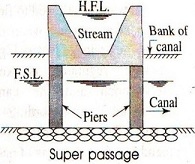 super passage. This structure is suitable when the bed level of drainage is above the flood surface level of the canal. The water of the canal passes clearly below the drainage.
super passage. This structure is suitable when the bed level of drainage is above the flood surface level of the canal. The water of the canal passes clearly below the drainage.
A super passage typically consists of an elevated structure, such as a bridge or culvert, with specialized features that facilitate the safe and unobstructed movement of wildlife. It may include vegetated slopes, artificial streams, and other elements that mimic the natural environment and encourage the passage of various species. A super passage is similar to an aqueduct, except in this case the drain is over the canal.
The FSL of the canal is lower than the underside of the trough carrying drainage water. Thus, the canal water runs under the gravity. Super passages are essential for maintaining biodiversity, promoting ecological balance, and reducing the fragmentation of habitats caused by human activities. It is the reverse of an aqueduct
Classification of Aqueduct and Siphon Aqueduct
Depending upon the nature of the sides of the aqueduct or siphon aqueduct it may be classified under three headings:
Type I:
Sides of the aqueduct in earthen banks with complete earthen slopes. The length of culvert should be sufficient to accommodate both, water section of canal, as well as earthen banks of canal with aqueduct slope. Sides of the aqueduct in earthen banks, with other slopes supported by masonry wall. In this case, canal continues in its earthen section over the drainage but the outer slopes of the canal banks are replaced by retaining wall, reducing the length of drainage culvert.
Type II:
Sides of the aqueduct made of concrete or masonry. Its earthen section of the canal is discontinued and canal water is carried in masonry or concrete trough, canal is generally flumed in this section.




